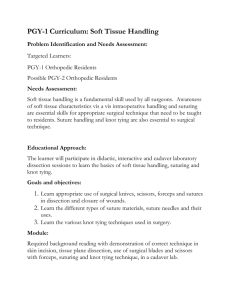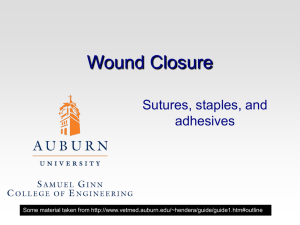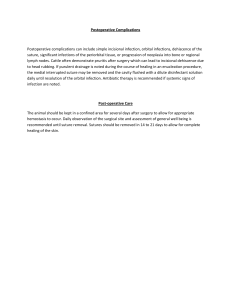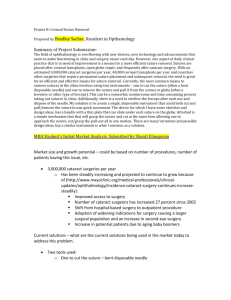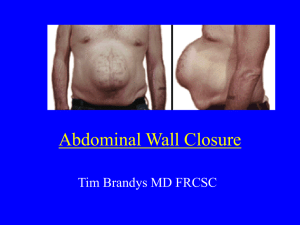File
advertisement
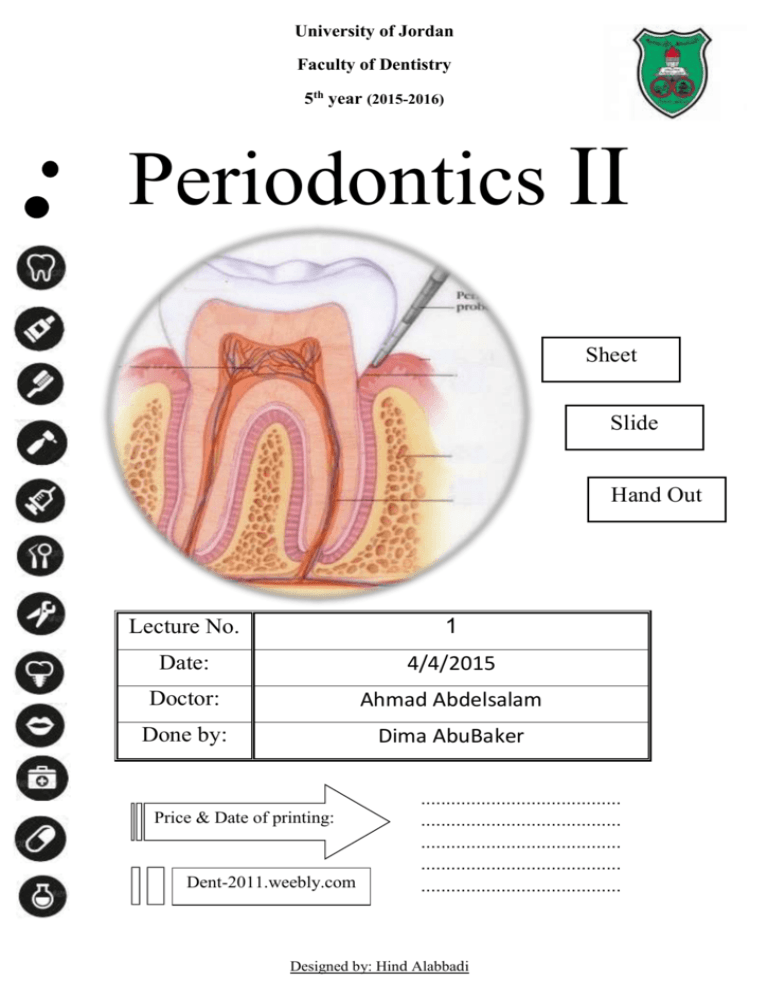
University of Jordan Faculty of Dentistry 5th year (2015-2016) Periodontics II Sheet Slide Hand Out Lecture No. 1 Date: 4/4/2015 Doctor: Ahmad Abdelsalam Done by: Dima AbuBaker Price & Date of printing: Dent-2011.weebly.com ........................................ ........................................ ........................................ ........................................ ........................................ ........................................ ......... Designed by: Hind Alabbadi Dr.Ahmad Abdelsalam Dima AbuBaker Perio sheet1 4/4/2015 Suture and Suture Materials Main Goals of Suturing 1- Accelerate healing 2- Approximation of the tissues without tension Tension leads to blood flow reduction and tissue tear which all cause ischemia, necrosis and opening of the wound (due to the inflammatory healing stage causing edema which facilitates the wound opening) 3- Prevent contamination with the oral cavity As important as incision placement and flap management are to the outcome of the surgical procedure, flap adaptation and stabilization at the end of the procedure are equally important. The surgeon must not rely on sutures to pull the flap beyond its passive positioning ( flap should stay adapted to its position without suture , sutures help stabilize) , as tension is created on the flap. In the images, left image shows sutures approximating the ends to protect the marginal bone Right Image shows full closure without tension ( as the mucosal folds are present ( tissue not taught) and there is no blanching ) 4- Compression of blood vessels for hemostasis : specially used on the palate when flaps extends beyond the upper 6 , excessive bleeding happens , therefore a suture is placed by passing the suture needle bello the artery ( greater palatine artery) and along the bone then tied to occlude it and stop the bleeding 5- Provide adequate tension of wound closure : to prevent No dead space Loose enough to obviate ischemia & necrosis 6789- Provide support for tissue margins until healing Reduce postoperative pain Prevent bone exposure Permit proper flap position Dr.Ahmad Abdelsalam Dima AbuBaker Perio sheet1 4/4/2015 Specially in Coronal advancement flap, lateral repositioning , apical repositioning flap . Suture Materials 1- Resorb able/ Non-resorb able 2- Synthetic/Natural Ideal Suturing Material Pliability, for ease of handling (user friendly) Knot security Sterilizability Appropriate elasticity Non-reactivity Adequate tensile strength for wound healing Chemical biodegradability (opposed to foreign body breakdown) meaning a material that the body wont recognize as foreign to prevent inflammation reaction Examples of suture materials 1- Natural Non-absorbable Silk (braided) ePTFE (monofilament) Nylon (monofilament) Polyester (braided) Absorbable Plain gut (monofilament) Chromic gut (monofilament) 2- Synthetic Polyglycolic (Vicryl) (braided) Polyglycaprone (Monocryl) (monofilament) Polyglyconate (monofilament) Dr.Ahmad Abdelsalam Dima AbuBaker Perio sheet1 4/4/2015 Choice of Material ( although preference of practitioner determines the material to be used ) 1-Surgical procedure (Ex. For simple extraction and apically repositioned flaps the use of silk is a good choice However, silk is week in tensile strength and knot security While Asethetic procedure, implants, bone graft, soft tissue grafts there is a risk of exposure , it’s better to use a higher tensile strength material like Vicyrl , Nylon or ePTFE 2-Biocompatibility 3-Clinical experience & preference 4-Quality & thickness of tissue ex. Using 30 gauge in a thin tissue like the gingiva and causes tissue tear . in Perio , 40 ,50 or 60 are only used 5-Rate of absorption vs. time for tissue healing Absorption has to be after the healing or in accordance with it . Knots Knots have to be flat Suture security is the ability of the knot and material to maintain tissue approximation during the healing process. Since the knot strength is always less than the tensile strength of the material, ( this is because the length is less and friction of the material within the knot) when force is applied, the site of disruption is always the knot.( this explains why the knot should not be placed over the wound ) Dr.Ahmad Abdelsalam Dima AbuBaker Perio sheet1 4/4/2015 Security of the Knot Depends on Coefficient of friction within the knot which is determined by 1-Nature of the material 2-Suture diameter 3-Type of knot Basic suture silk User friendly Inferior to other materials in terms of strength High degree of tissue reaction ( because of the high wettability of the silk , it becomes soaked with saliva , the knot slippage would be higher )) Knot Anatomy 3 components Loop: created by the knot Knot: composed of a number of tight throws Ears: the cut ends of the suture The knot directions are variable according to opinions , if you do the first clockwise knot then anticlockwise this usually determines the tension and prevents you from correcting it with the final knot However if you do the first two knots in the same direction then do the last knot in opposite direction this means you can control the tension . Note , the three knots (steps) mean stabilize , secure and block . Principles of Suturing 1.Completed knot must be tight,firm,&tied so slippage will not occur Dr.Ahmad Abdelsalam Dima AbuBaker Perio sheet1 4/4/2015 2.To avoid wicking of bacteria,knots should not be placed in incision lines 3.Knots should be small&the ends cut short(2-3mm) Why short ( so the knot wont slip , and the ends wont discomfort the pt) 4.Avoid excessive tension to finer-gauge materials because breakage may occur 5.Avoid using a jerking motion,which may break the suture tying ( never take one bite for the two ends. Also , if the suture slips through the tissue after taking a bite , you should try to re-enter through the same point as the first to minimize blood vessel damage ) 6.Avoid crushing or crimping of suture material by not using needle holders on the the free end for 7.Do not tie sutures too tightly because tissue necrosis may occur(Avoid tissue blanching) 8.Maintain adequate traction on one end while tying to avoid loosening the first loop. Suture Removal Area should be swabbed with H2O2(removal of encrusted necrotic tissue & blood and kills the bacteria) Sharp suture scissors should be used to cut the loops of sutures (use an explorer to lift the sutures if they are in the sulcus or closely adapted to the tissue) Never use the blade as it requires traction of the suture and cause injury to the fragile healed tissues. A cotton pliers is used to remove the sutures Surgical Needle Design Eye:press-fitted( press closed over the suture material ) or swaged( has a hole in which suture material is inserted) Body:widest point of needle, called grasping area Point:runs from the tip to the maximum cross-sectional area of the body (conventional cutting, reverse cutting, side cutting, taper cut, …) Dr.Ahmad Abdelsalam Dima AbuBaker Perio sheet1 4/4/2015 Cutting : it cuts above and bellow ( 2 cuts) While reverse cutting it only causes 1 cut bellow its entry point while the upper part is secured with the suture Round is best but its handling is difficult . Note ,Never hold the needle from its point with holder as it bends and blunts out Needle Holder Selection 1.Approximate size for agiven needle The smallerthe needle,the smaller the needle holder required 2.Needle should be grasped ¼to½ the distance from the swaged area to the point 3.The tips of the jaws of the needle holder should meet before the remaining portions 4.Needle should be placed securely in the tips of the jaws without rocking,twisting or turning 5.Avoid over closure of the needle holder to avoid damaging the needle 6.Needle holder should be directed by the thumb Always use the needle holder so that it’s directed outside the pt’s mouth Needle Placement 1.Force applied in the direction following the curvature of the needle 2.Suturing from movable to non-movable tissue 3.Avoid excessive tissue bites with small needles 4.Sharp needles should be used with minimal force 5.Do not hold the swaged area nor the point area 6.Needle should penetrate tissue at right angles(never force needle) 7.Avoid retrieving the needle from the tissue from the tip 8.Adequate bite is required (2-3mm)to avoid tissue tearing Suturing Techniques Interrupted is mostly used as it provides the best control of the surgical site Continuous : is faster used in large flaps and short time left Dr.Ahmad Abdelsalam Dima AbuBaker Perio sheet1 The choice of technique Individual operator’s preference Educational background Skill level Surgical requirements Periosteal Suturing It mainly stabilizes the tissue by connecting it through the suture with the underlying ( periosteal tissue) Interrupted Sutures Circumferential, direct, or loop Figure eight ( out-in then on the other end out-in) Vertical or horizontal mattress Intrapapillary placement A variant of the horizontal mattress is the cross or X suture At one end you start out-in then on the opposing end in-out Then enter the first end as out-in Please note that I have added all the information that the Doctor mentioned during the lecture . Please go back to the handout for the illustrations Best of Luck Seniors 4/4/2015

